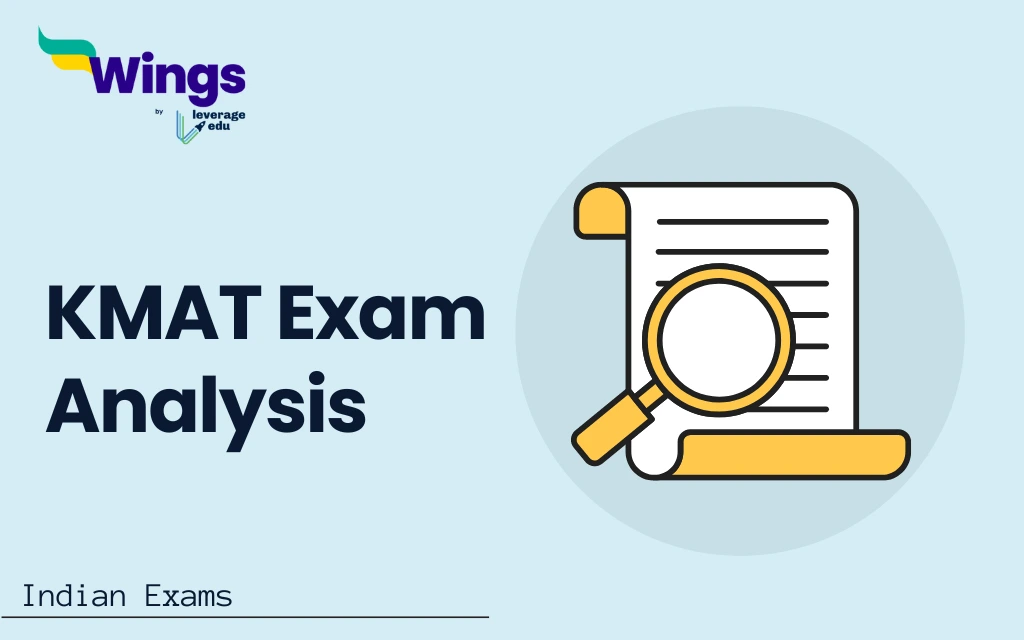KMAT Exam Analysis: The Karnataka Management Aptitude Test or KMAT exam is conducted for admission to top management institutes in Karnataka. The KMAT exam is conducted by the Karnataka Graduate Private Colleges Association (KPPGCA) every year to select the meritorious candidates to get admitted to MBA, MCA and Post Graduate Diploma in Management (PGDM) courses in Karnataka’s colleges. In the below article, the candidates will get to know about the detailed KMAT Exam Analysis.
| Particulars | Details |
| Exam Name | Karnataka Management Aptitude Test |
| Exam Short Name | KMAT |
| Exam Frequency | Once a year |
| Exam Mode | Home Based on Online remote Proctored test |
| Exam Duration | 2 hours |
| Exam Language | English |
| KMAT Exam Date | 3rd week of February 2024 |
| Number of Test Cities | 13 |
| Exam Level | State Level |
| Official Website | https://www.kmatindia.com/ |
Contents
KMAT Exam Analysis 2024
Candidates can get to know about the difficulty of the KMAT 2024 exam through previous years’ exam analysis. Below mentioned are the KMAT exam analysis for the years 2022 and 2021:
KMAT Exam Analysis 2022
The Karnataka Management Aptitude Test or KMAT 2022 exam was conducted in the home-based online remote proctored mode. The question paper of the KMAT exam consists of three sections and each section has 40 questions. The overall question paper consists of 120 questions and each question carries 1 mark. Below is the section-wise KMAT exam analysis for 2022:
| Sections | Good Attempts | Difficulty Level |
| Logical Reasoning | 28-32 | Moderate |
| Verbal Ability and Reading Comprehension | 30-35 | Easy to Moderate |
| Quantitative Ability | 29-34 | Moderate |
Also Read: Karnataka Management Aptitude Test (KMAT) – Latest Updates, Important Dates, Syllabus
KMAT Exam Analysis 2021
Karnataka Management Aptitude Test or KMAT 2021 was conducted in a home-based proctored mode across the state. KMAT exam consists of three sections which are Quantitative Ability, Logical Reasoning and Verbal Ability and Reading Comprehension. In the below-mentioned table, there is a column for the difficulty level and the number of good attempts for the year 2021:
| Sections | Good Attempts | Difficulty Level |
| Logical Reasoning | 24-29 | Easy to moderate |
| Verbal Ability and Reading Comprehension | 29-32 | Easy to moderate |
| Quantitative Ability | 30-35 | Easy to moderate |
Also Read: KMAT Eligibility Criteria 2023
Expected Difficulty Level of KMAT 2024 based upon Previous Year’s Exam Analysis
Based on several reviews collected from students who have appeared in the previous years’ KMAT exam, the difficulty level of the exam is expected to be between Easy to moderate. The students can clear the exam if they have studied nicely.
KMAT Exam Pattern
The exam pattern for the KMAT 2024 exam has been released on its official website. The KMAT exam pattern contains MCQ-type questions. To get a deep understanding of the KMAT Exam Pattern 2024, candidates must check the table given below:
| Particulars | Details |
| Number of Sections | Four |
| Subjects | Verbal and Reading Comprehension Logical Reasoning Quantitative Aptitude |
| Exam Mode | Computer-based Test |
| Exam Duration | 3 hours |
| Number of questions | 120 MCQs |
| Total Marks | 120 Marks |
| Exam Language | English |
| Marking Scheme | +1 Mark for each correct answer No negative marking for an incorrect answer No marks will be given or deducted for unattempted questions |
KMAT Exam 2024 Section-wise Weightage
The division of marks in the KMAT exam along the three sections is given below. Candidates can check the same to get an idea of how to prepare for the exam.
| Sections | Questions | Total Marks |
| Quantitative Aptitude | 50 | 40 |
| Verbal Ability and Reading Comprehension | 40 | 40 |
| Logical Reasoning | 40 | 40 |
| Total | 130 | 120 |
FAQs
There are a total of three sections which consist of Quantitative Aptitude, Logical Reasoning and Verbal Ability and Reading Comprehension.
There are 40 questions in each of the three sections of the KMAT exam and in total, there are 120 questions.
The marking scheme of the KMAT exam is one mark for each correct answer. There is no negative marking for an incorrect answer. No marks will be given or deducted for questions which are not attempted.
For more such informative blogs, check out our Management Exams Section, or you can learn more about us by visiting our Indian exams page.
 One app for all your study abroad needs
One app for all your study abroad needs














